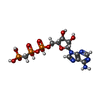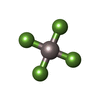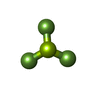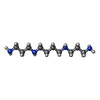+Search query
-Structure paper
| Title | Cryo-EM reveals mechanistic insights into lipid-facilitated polyamine export by human ATP13A2. |
|---|---|
| Journal, issue, pages | Mol Cell, Vol. 81, Issue 23, Page 4799-44809.e5, Year 2021 |
| Publish date | Dec 2, 2021 |
 Authors Authors | Atsuhiro Tomita / Takashi Daiho / Tsukasa Kusakizako / Keitaro Yamashita / Satoshi Ogasawara / Takeshi Murata / Tomohiro Nishizawa / Osamu Nureki /   |
| PubMed Abstract | The cytoplasmic polyamine maintains cellular homeostasis by chelating toxic metal cations, regulating transcriptional activity, and protecting DNA. ATP13A2 was identified as a lysosomal polyamine ...The cytoplasmic polyamine maintains cellular homeostasis by chelating toxic metal cations, regulating transcriptional activity, and protecting DNA. ATP13A2 was identified as a lysosomal polyamine exporter responsible for polyamine release into the cytosol, and its dysfunction is associated with Alzheimer's disease and other neural degradation diseases. ATP13A2 belongs to the P5 subfamily of the P-type ATPase family, but its mechanisms remain unknown. Here, we report the cryoelectron microscopy (cryo-EM) structures of human ATP13A2 under four different conditions, revealing the structural coupling between the polyamine binding and the dephosphorylation. Polyamine is bound at the luminal tunnel and recognized through numerous electrostatic and π-cation interactions, explaining its broad specificity. The unique N-terminal domain is anchored to the lipid membrane to stabilize the E2P conformation, thereby accelerating the E1P-to-E2P transition. These findings reveal the distinct mechanism of P5B ATPases, thereby paving the way for neuroprotective therapy by activating ATP13A2. |
 External links External links |  Mol Cell / Mol Cell /  PubMed:34798056 / PubMed:34798056 /  PubMed Central PubMed Central |
| Methods | EM (single particle) |
| Resolution | 3.54 - 3.92 Å |
| Structure data | EMDB-32066, PDB-7vpi: EMDB-32067, PDB-7vpj: EMDB-32068, PDB-7vpk: EMDB-32069, PDB-7vpl: |
| Chemicals |  ChemComp-ACP:  ChemComp-MG:  ChemComp-ADP:  ChemComp-NAG:  ChemComp-ALF:  ChemComp-BEF:  ChemComp-SPM: |
| Source |
|
 Keywords Keywords |  MEMBRANE PROTEIN / MEMBRANE PROTEIN /  ATP13A2 / ATP13A2 /  PARK9 / PARK9 /  P-type ATPase P-type ATPase |
 Movie
Movie Controller
Controller Structure viewers
Structure viewers About Yorodumi Papers
About Yorodumi Papers












